The Power of Personalization in Email Marketing Campaigns
In today’s digital landscape, where consumer attention is fleeting, personalization in email marketing campaigns has emerged as a game changer. Unlocking success goes beyond generic greetings; it’s about crafting tailored messages that resonate deeply with your audience’s needs and preferences. Imagine receiving an email that not only acknowledges your interests but also anticipates your next steps—this is the power of personalization. By leveraging data insights, businesses can create campaigns that feel uniquely relevant, fostering stronger connections and boosting engagement. As we delve into the strategies behind effective personalization, you’ll discover how to transform your email marketing efforts into a dynamic conversation. Are you ready to elevate your campaigns and drive real results? Let’s explore the untapped potential of personalization that can turn ordinary emails into powerful marketing tools.
Understanding Personalization in Email Marketing
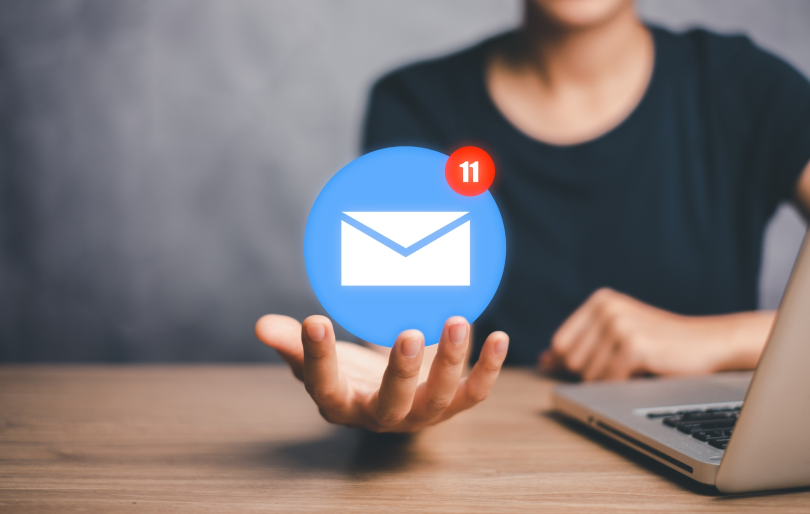
In an era where consumers are inundated with digital content, standing out in the crowded inbox is no small feat. Personalization in email marketing refers to the practice of tailoring email messages to individual recipients based on their preferences, behavior, and demographics. This approach goes far beyond the generic “Dear Customer” salutation. Instead, it leverages data to create highly relevant and engaging content that speaks directly to the recipient’s interests and needs.
At its core, personalization aims to create a sense of connection and relevance. By incorporating elements such as the recipient’s name, past purchase history, browsing behavior, and even location, marketers can craft messages that feel uniquely tailored. This not only captures attention but also fosters a deeper sense of loyalty and trust. When consumers feel understood and valued, they are more likely to engage with the content and take the desired action. See how AR and VR are shaping digital marketing with personalized tech experiences.
The journey towards effective personalization begins with a deep understanding of your audience. This involves collecting and analyzing data to uncover insights about their preferences, behaviors, and motivations. By leveraging this information, you can segment your audience and deliver messages that resonate on a personal level. The result is a more engaging and effective email marketing campaign that drives higher open rates, click-through rates, and conversions.
The Importance of Personalization for Engagement and Conversion
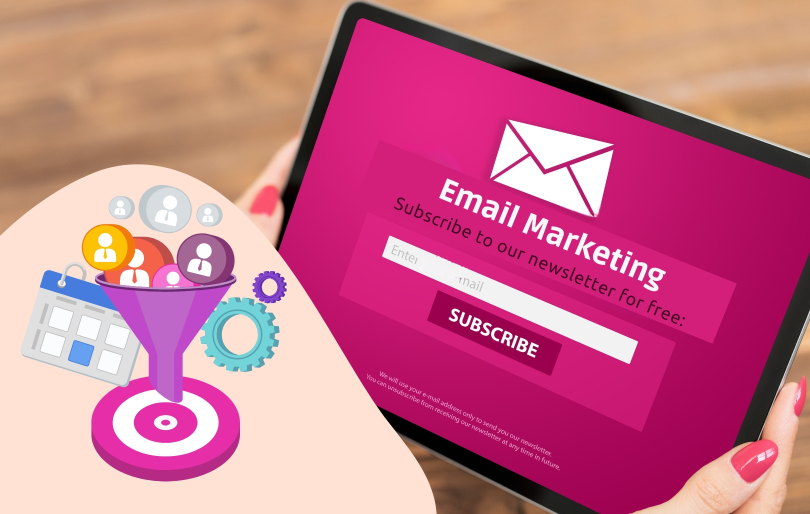
Personalization is not just a buzzword; it’s a critical component of successful email marketing campaigns. The importance of personalization lies in its ability to drive engagement and conversion by creating a more relevant and enjoyable experience for the recipient. When emails are personalized, they are more likely to capture the recipient’s attention, evoke positive emotions, and inspire action.
Engagement is a key metric in email marketing, and personalized emails have been shown to significantly boost engagement rates. According to studies, personalized emails can achieve higher open rates and click-through rates compared to non-personalized emails. Learn more in our holiday marketing tips for local businesses which leverage timely, personalized promotions. This is because personalized content feels more relevant and tailored to the recipient’s interests, making them more likely to interact with the email. Moreover, personalized emails can reduce unsubscribe rates, as recipients are less likely to disengage from content that feels meaningful and valuable to them.
Conversion is the ultimate goal of any marketing campaign, and personalization plays a crucial role in driving conversions. By delivering content that is specifically tailored to the recipient’s needs and preferences, you can guide them through the customer journey more effectively. Personalized emails can include product recommendations based on past purchases, special offers for items left in the cart, and timely reminders about upcoming events or promotions. These targeted messages can nudge recipients towards making a purchase, resulting in higher conversion rates and increased revenue for your business.
Key Statistics on Email Personalization
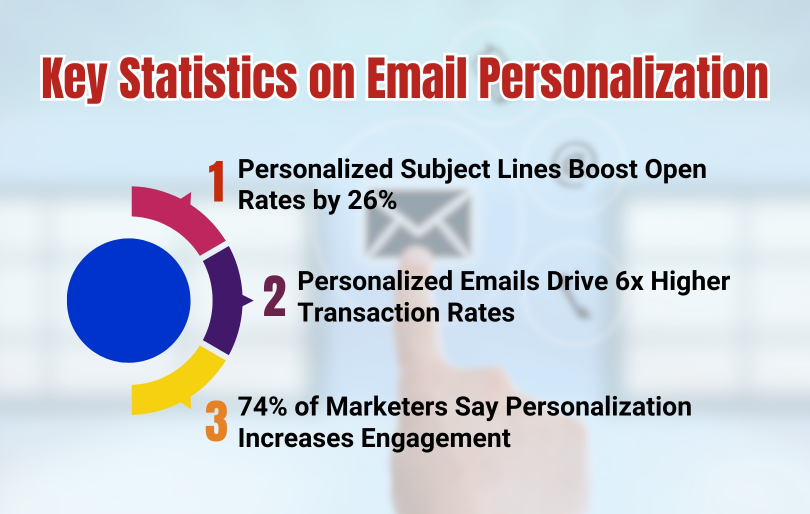
Email personalization is no longer just a trend—it’s a proven strategy that drives better results across open rates, engagement, and conversions. Backed by strong data, personalization has become an essential part of effective email marketing campaigns. Below are some of the most compelling statistics that illustrate its impact.
Personalized Subject Lines Boost Open Rates by 26%
Subject lines are your first chance to capture attention, and personalization makes a significant difference. Emails with personalized subject lines are 26% more likely to be opened. Including the recipient’s name or a relevant topic can spark curiosity and signal that the content inside is tailored specifically to them.
Personalized Emails Drive 6x Higher Transaction Rates
When emails are customized based on user behavior or preferences, they don’t just get opened—they convert. Personalized emails have been shown to generate six times more transactions than their generic counterparts. This statistic underscores the power of relevant content in moving subscribers to take meaningful action.
74% of Marketers Say Personalization Increases Engagement
The majority of marketers agree: personalization enhances customer engagement. In fact, 74% say targeted personalization leads to better interaction with email content. As consumers grow more selective, sending messages that speak directly to their needs and interests can significantly boost both satisfaction and loyalty.
Types of Personalization Techniques in Email Marketing
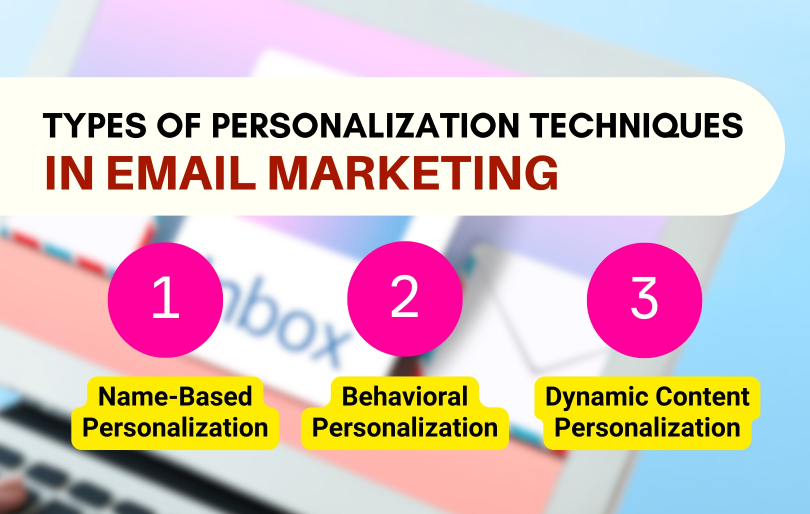
Email personalization is more than just using a recipient’s name—it encompasses a variety of methods that make your messages more relevant and impactful. By incorporating different personalization techniques, you can create emails that truly resonate with your audience and drive better results. Below are some of the most effective approaches used by marketers today.
1. Name-Based Personalization
One of the simplest and most widely used techniques is including the recipient’s name in the email. Whether it’s in the subject line or the opening greeting, using someone’s name adds a personal touch that can increase engagement. A personalized greeting like “Hi Sarah” feels more direct and friendly than a generic alternative, helping to build a stronger connection with your audience.
2. Behavioral Personalization
This approach tailors content based on the recipient’s previous actions, such as their browsing behavior, past purchases, or interactions with prior emails. For example, if a user recently viewed hiking gear on your website, you can send them an email featuring top-rated hiking boots or related accessories. Behavioral personalization ensures your emails are timely, relevant, and more likely to convert.
3. Dynamic Content Personalization
Dynamic content allows you to show different content blocks to different recipients within a single email campaign. By using customer data—such as location, preferences, or purchase history—you can display customized images, offers, or product recommendations. This method delivers a highly tailored experience that can significantly boost engagement and conversion rates.
How to Collect Data for Effective Personalization
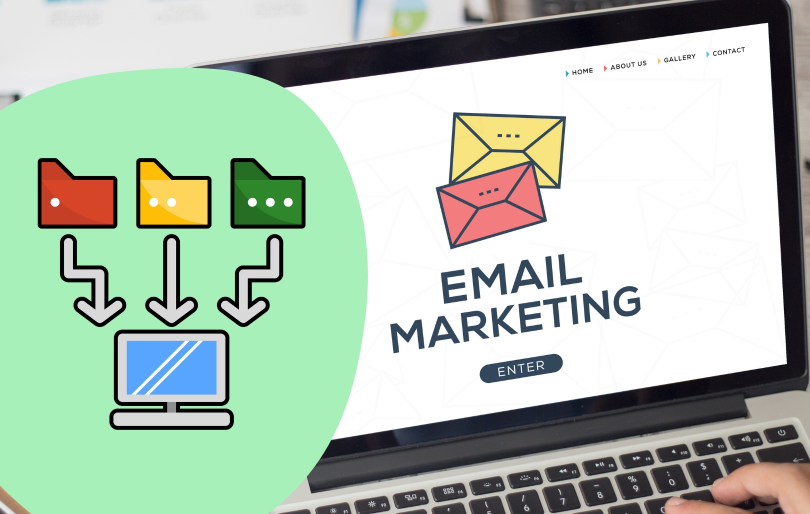
Effective personalization begins with the collection of high-quality data. The more accurate and comprehensive your data, the more effectively you can personalize your email campaigns. There are several strategies and tools you can use to collect data for personalization.
One of the primary sources of data is your website. By tracking user behavior on your site, you can gather valuable insights into their preferences, interests, and actions. Tools like Google Analytics can help you monitor page views, clicks, and other interactions, providing a wealth of information that you can use to personalize your emails. Additionally, implementing website cookies can help you track returning visitors and understand their behavior over time.
Another important source of data is email engagement. By analyzing how recipients interact with your emails, you can gain insights into their preferences and interests. This includes tracking open rates, click-through rates, and the specific links they click on. Email marketing platforms like Mailchimp and HubSpot offer built-in analytics tools that can help you monitor and analyze email engagement data. This information can be used to tailor future emails to better meet the recipient’s needs and preferences.
Surveys and feedback forms are also valuable tools for collecting data. By directly asking your audience about their preferences, interests, and opinions, you can gather firsthand information that can inform your personalization efforts. This can include surveys sent via email, feedback forms on your website, or even social media polls. The key is to ask relevant questions that provide actionable insights, allowing you to create more personalized and engaging email content.
Crafting Personalized Email Content
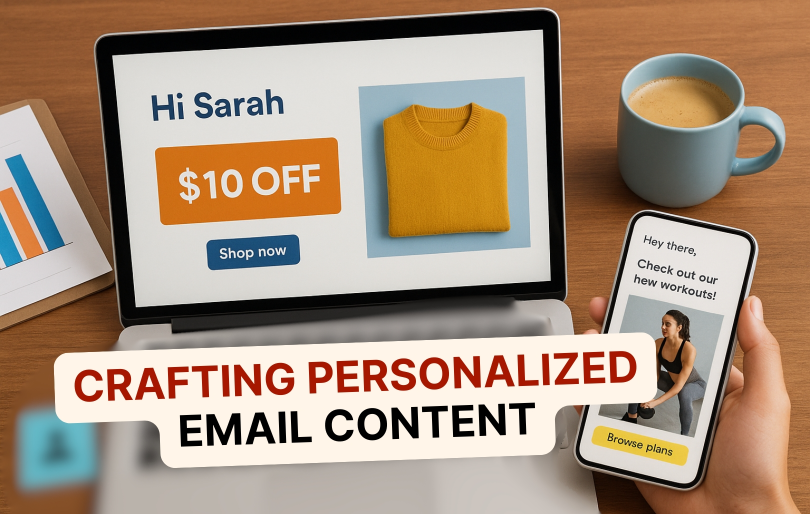
Once you have collected and analyzed your data, the next step is to craft personalized email content that resonates with your audience. This involves using the insights you have gathered to create messages that are relevant, engaging, and tailored to the recipient’s needs and preferences.
One of the most effective ways to personalize email content is by using dynamic content blocks. These are sections of your email that can be customized based on the recipient’s data. For example, you can use dynamic content to display different product recommendations, offers, or images based on the recipient’s past behavior or preferences. This allows you to create a more relevant and engaging experience, increasing the chances of conversion.
Another important aspect of personalized email content is the tone and language you use. Personalization is not just about including the recipient’s name; it’s also about speaking to them in a way that feels personal and relevant. This means using language that resonates with their interests and preferences, and addressing their specific needs and pain points. For example, if you know that a recipient is interested in fitness, you can use language and imagery that reflects this interest, creating a more engaging and relevant message.
Timing is also a crucial factor in personalized email content. Sending emails at the right time can significantly impact engagement and conversion rates. By analyzing data on when recipients are most likely to open and engage with emails, you can schedule your campaigns to reach them at the optimal time. This can include sending emails based on time zones, past behavior, or even specific events or milestones. The goal is to deliver your message when it is most likely to be seen and acted upon, creating a more effective and engaging email campaign.
Segmenting Your Audience for Better Personalization
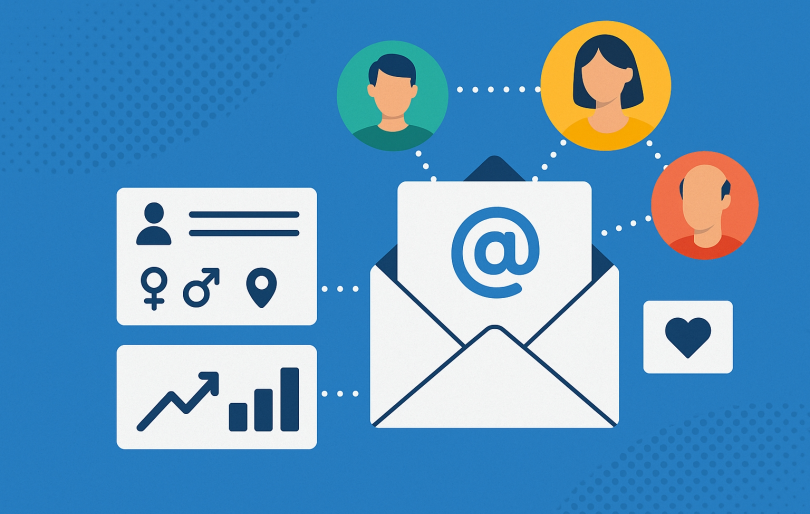
Audience segmentation is a critical step in personalizing your email marketing campaigns. By dividing your audience into smaller, more targeted segments, you can deliver content that is more relevant and engaging to each group. Tap into latest local SEO trends in 2024 to refine your segmentation based on geography. There are several strategies and criteria you can use to segment your audience.
One common approach is demographic segmentation, which involves dividing your audience based on characteristics such as age, gender, location, and income. This allows you to tailor your messages to the specific needs and preferences of different demographic groups. For example, you can create different email campaigns for different age groups, highlighting products or offers that are most relevant to each group.
Behavioral segmentation is another powerful strategy that involves dividing your audience based on their past actions and interactions. This can include their browsing history, purchase behavior, and engagement with previous emails. By understanding how different segments of your audience behave, you can create more targeted and relevant messages. For example, you can send targeted emails to customers who have abandoned their carts, offering special discounts or reminders to encourage them to complete their purchase.
Psychographic segmentation involves dividing your audience based on their interests, values, and lifestyle. This approach goes beyond demographic data to understand the deeper motivations and preferences of your audience. By creating segments based on psychographic data, you can deliver more personalized and engaging content that resonates with the recipient’s values and interests. For example, you can create email campaigns that highlight eco-friendly products for environmentally conscious customers, or promote luxury items to those who value high-end brands.
Future Trends in Email Personalization

As technology continues to evolve, the future of email personalization holds exciting possibilities. Staying ahead of these trends can help you create more effective and engaging email marketing campaigns.
One emerging trend is the use of artificial intelligence (AI) and machine learning to enhance personalization. These technologies can analyze vast amounts of data to uncover patterns and insights that humans may miss. For example, AI can predict the best time to send emails, recommend personalized content, and even generate personalized subject lines. By leveraging AI and machine learning, marketers can create more sophisticated and effective personalization strategies.
Interactive emails are another trend that is gaining traction. These emails include interactive elements such as quizzes, surveys, and polls, allowing recipients to engage directly with the content. This not only creates a more engaging experience but also provides valuable data that can be used for further personalization. For example, you can use the results of a quiz to send personalized product recommendations or offers.
Privacy and data protection are also becoming increasingly important in email personalization. As consumers become more aware of their data privacy rights, marketers need to be transparent and ethical in their data collection and usage practices. This includes obtaining explicit consent, providing clear opt-out options, and ensuring data security. By prioritizing privacy and data protection, you can build trust with your audience and create a more positive and ethical marketing experience.
In conclusion, personalization in email marketing is a powerful tool for driving engagement and conversion. By understanding your audience, collecting and analyzing data, and using the right tools and techniques, you can create highly relevant and engaging email campaigns. As technology continues to evolve, staying ahead of future trends can help you unlock even greater success in your email marketing efforts. If you’re looking to amplify your outreach, e-mail marketing by Adzeem in MD or VA offers personalized, data-driven solutions designed to convert leads into loyal customers.
